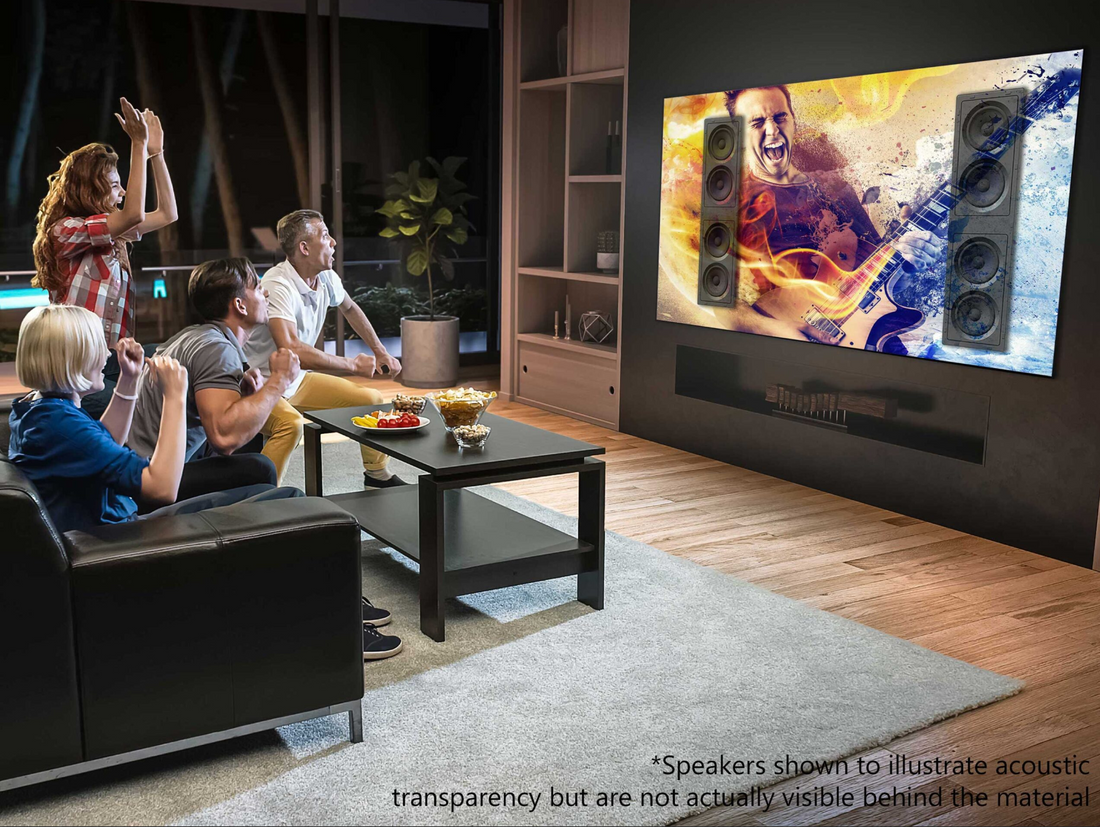
Understanding Active and Passive 3D Screens. Elite Screens Cinegrey 4D/Cinegrey 5D Screens
Share
The buzz around 3D technology often leads to confusion, particularly when discussing active and passive 3D screens. What precisely distinguishes these technologies, and how do they influence your viewing experience?
In a brief explanation we can say:
Active 3D
Active 3D works with shutter glasses and the projector’s signal to create the 3D effect. The screen itself doesn’t generate 3D; instead, a high-contrast surface such as CLR® or CineGrey® simply reflects the image back with greater clarity and contrast. This makes Active 3D particularly well-suited for home use, as it’s easier to set up and only depends on the projector and glasses technology.
- Screen Requirement: Works on almost any projection screen; high-gain or high-contrast surfaces help compensate for brightness loss caused by shutter glasses.
- Image Quality: Very sharp, since each eye receives a full HD image alternately.
- Use Case: Ideal for home theaters, gaming, or private viewing.
Passive 3D
Passive 3D uses polarized light and glasses, which requires a special polarization-preserving screen surface (often silver or specially coated). Unlike Active 3D, the screen here plays a critical role in maintaining polarization.
- Screen Requirement: Needs a dedicated 3D screen (e.g., silver or coated) to preserve polarization.
- Image Quality: Resolution is divided between both eyes, which can appear slightly softer than Active 3D.
- Use Case: Commonly used in commercial cinemas and for large audience setups.
Let's delve into the nuances of active and passive 3D, exploring their working principles, differences in viewing effects, suitable equipment, and the overall viewing experience.
Working Principle:
**Active 3D (Shutter 3D):**
Active 3D operates by displaying different images to each eye, rapidly alternating between left and right-eye pictures to create a three-dimensional effect. It requires the use of active 3D glasses equipped with LCD screens or polarizers, which control what each eye sees.
**Passive 3D (Polarized 3D):**
Passive 3D, on the other hand, presents the same image simultaneously to both eyes but uses polarizing plates or optical principles to separate the left-eye and right-eye pictures, generating the illusion of depth. Passive 3D glasses, usually with polarizers, manage what each eye perceives.
### Viewing Effect:
**Active 3D:**
The viewing effect of active 3D is often more realistic due to its ability to control each eye's image separately, heightening the three-dimensional experience. However, the cost of active 3D glasses is higher, and some viewers might notice flickering during the viewing process, potentially causing discomfort.
**Passive 3D:**
Passive 3D tends to offer a slightly weaker stereoscopic effect compared to active 3D. Nonetheless, it provides a stable viewing experience with lower-cost glasses, minimizing discomfort and image flickering.
### Applicable Equipment:
**Active 3D:**
Suited for a range of media such as TV, movies, and gaming, active 3D offers higher picture quality and a more realistic three-dimensional experience.
**Passive 3D:**
Widely employed in movie theaters, television, and gaming, passive 3D may offer a weaker three-dimensional experience, but it tends to provide a more comfortable viewing experience overall.
### Viewing Experience:
**Active 3D:**
The experience with active 3D is immersive, delivering a highly realistic three-dimensional feeling. However, due to the higher cost of glasses, it might be less comfortable during extended viewing sessions.
**Passive 3D:**
The passive 3D experience is relatively easy, with low-cost glasses and minimal discomfort during extended viewing periods.
In essence, both active and passive 3D technologies come with their set of advantages and disadvantages. The choice between the two largely depends on personal preferences and specific needs. Active 3D may offer a more immersive experience and higher quality visuals but at a higher cost, while passive 3D, although slightly less realistic, provides a more comfortable and affordable viewing experience. Ultimately, the right choice depends on your viewing priorities and comfort preferences.
Our fabric screens such as C4D/C5D are more suitable for active 3D.
 Explore Electric Projection Screens
Explore Electric Projection Screens Electric Floor-Up Screens
Electric Floor-Up Screens Explore High Contrast Screens
Explore High Contrast Screens Explore Screen Materials
Explore Screen Materials Frame Projection Screens
Frame Projection Screens Explore All Portable Screens
Explore All Portable Screens Explore All Manual Screens
Explore All Manual Screens English
English German
German French
French Spanish
Spanish Italian
Italian Netherland
Netherland